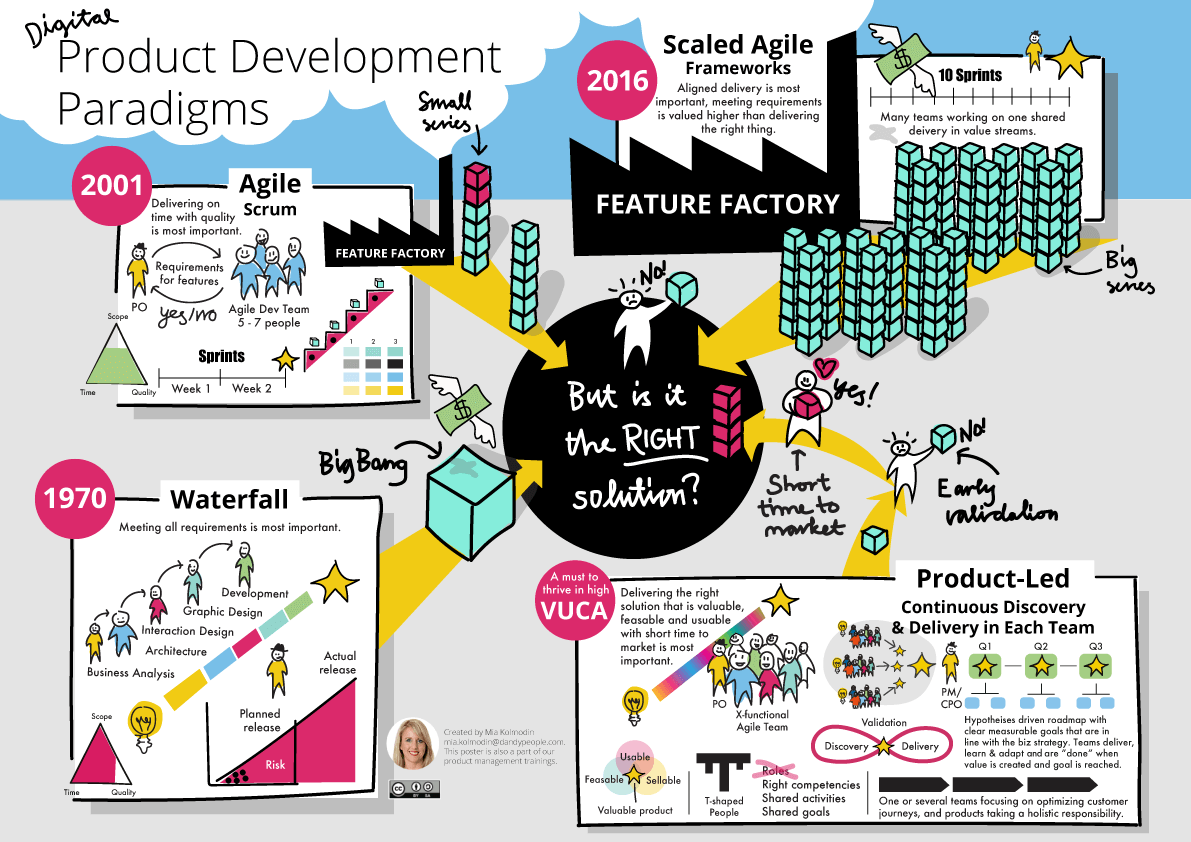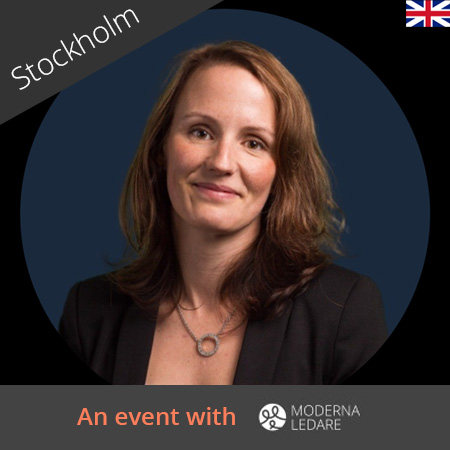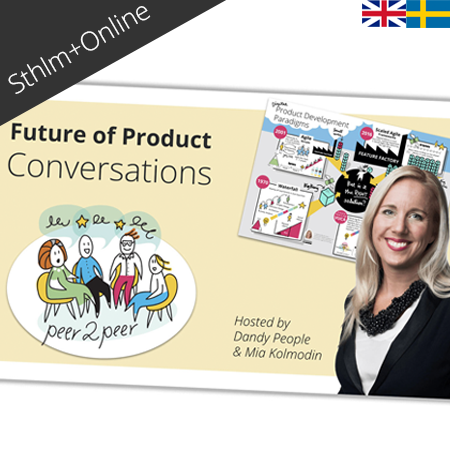The idea of the organization as a machine is a metaphor that was common 150 years ago, but many people are experiencing it right now too. This is common when what is asked for, and celebrated, is output oriented. Like, for instance, the number of “things” being delivered is counted, reported and the goal is “met” when the ”right” number of features has been shipped. What seems to be lost in theese organizations is the purpose of the organization. What is the actual customer- and business value that the organization should aim to deliver to be successful?
The actual purpose of the organization
The purpose of an organization is of course never to do a specific number of things, or to meet the numbers in budget but to deliver some kind of value to its customers. If you are a bank, maybe the value is making your customers housing dreams come true. And if you are in health care, maybe it is something like helping people live healthy lives longer – and helping those sick to become well faster. Today the trick is to understand this purpose and explore as quickly as possible what solutions would do the customer job-to-be-done they came to you for – as well as give the business vale you are looking for, with a feasable technical solution. To be able to do so we need to use hypothesis driven development, test things, throw them away and try new things. And this is often impossible to plan and co-ordinate if you are not working closely together.
Download the poster here for free in PDF >

Delivering the right thing
Sadly, it seems the main focus for many Agile transformations have been to decrease costs, or become more efficient in “IT”. Many would start by increasing the flow of the organization – which is totally fine, that is always the “first step” and to increase the speed of delivery to actually get something out to the customer. But after that, there should always be a focus on value. Delivering the right thing fast is what we should be looking for. To do so almost always you need to bring several parts of the organization together into one new organization. Often marketing, business, tech and others are needed to make the required shift to reduce “the cost in IT”. If this doesn’t happen, you might become really slow, or delivering the wrong things fast – making you a feature factory.
The creation and purpose of this poster
When I first learned about SAFe, sometime in 2016, I created this poster together with my colleague Per Lundström to visualize what I saw then as a huge business risk for organizations. It seemed then that they had forgotten all about the customer (the customer was not a part of the one-pager process), and it seemed they might have lost focus on what would be valuable outcomes and instead drowning in heavy processes, too many roles and hierarchy. At the same time, John Cuttler coined the concept of a “feature factory” which we borrowed in this poster. We were not alone to see this.
We have since then used it for our trainings on how teams could work with hypothesis driven product development and what was then known as Lean UX. We have now used it many times with our customers to set a perspective and shared vision. I now decided to publish it online due to the fact that this actually became the truth for many people in many oganizations – and they are still many sharing this vision, struggling how to create product-led organizations.
Today many of our customers have implemented some kind of “SAFe-inspired” large scale prescriptive framework. A prescriptive framework tells you “if you do this, you will get that” and it usually works pretty bad in complex business environments. Many times there is frustration around not having shared goals, many dependencies never getting solved, work has to be touched by all teams to be “done”, the work is never ending and it is hard to get something out no matter how hard they work. The heavy processes of a prescriptive framework is getting in the way of the smooth customer centric collaboration we should be doing. This usually happens due to only implementing “by the book” processes, with sometimes too little understanding of why and very often not removing other processes – ending up with too many overlapping roles and processes but still with unclear mandate or responsibility for those doing the work.
Organizing around the customer
My vision then (and still is) was to create customer centric team based organizations where people would organize around the customer instead of IT systems, resource optimized on several projects or locked within internal structures. Thinking first of what we want to achieve and for who, and then build teams with the right competencies based on that. It would then be possible to build digital products with customer focus, achieving business goals, enable innovation and remove a lot of wasteful work and handoffs. If a team has clear goals and KPIs that they have ownership over, that are connected to what’s valuable for the business, lets say monitization, and they have the people in the team needed to deliver on it – they can learn how to collaborate, build strong teams, and strong product ownership. That’s where true magic happens!
Moving from the old paradigm into the new
At Dandy People we have become somewhat of specialized in helping organizations move from the old paradigm, often this type of feature factory state, or proper old school project management even without teams or sometimes a more chaotic scale-up environment, towards a smooth effective and customer centric product-led organization.
This new setup has a totally new capacity in delivering real customer and business value. It is an organization fit for the future, as it is possible to evolve and constantly adapt based on new customer needs. It has to be product-led, which means focusing on both business and customer needs, creating a new way to manage the portfolio and building new management structures with cross functional leadership teams that speeds up both the flow of information from the teams as well as decision making based on facts and trends. The product governance model and frankly the operational model for the overall organization, also most times needs to be adjusted for collaborative cross functional work to happen. Most important are shared goals so that everyone is a part of the same entity, so that they actually need each other to succeed, on management levels as well as team level.
It might seem like a really though journey, but you know what? You can do it! But, you really need to collaborate to succeed. It will also get easier if you learn as much as possible from others who have done it. Their failures might be your success, and it will go faster if you ask for hands-on help from people who have done it.
Learn more about how to become Product-Led
We see a lot of interest in these topics now and you can of course find more on our digital channels. We are also running events, inviting those who have done it to share their story. Check out our YouTube for shorter videos and webinars, our blog, our other posters and our events and trainings.
Upcoming exclusive events on this topic
September 11 – On-site in Stockholm and online.
Free Breakfast Seminar – Digital Product Development Paradigms – How to Become Product-Led Instead of a Feature Factory
Mia Kolmodin presenting this poster and experiences around developing Product-Led organizations.
September 26 – On-site in Stockholm
Empowered product teams an Avanza and Incurello
Johanna Belfrage, CTO, sharing the story on how they created empowered product teams at both Avanza and Insurello.
Be there or…. Well, we hope to see you 🙂
Free to download, use and share
The posters are published under Creative Commons License, so please use it and share it as you like. If you are interested in doing a translation to any other languages, please let me know and I will help you with the file and publish it here on the blog as well.
You are free to:
Share — copy and redistribute the material in any medium or format
Adapt — remix, transform, and build upon the material for any purpose, even commercially.
This license is acceptable for Free Cultural Works.
The licensor cannot revoke these freedoms as long as you follow the license terms.
Under the following terms:
Attribution — You must give appropriate credit, provide a link to the license, and indicate if changes were made. You may do so in any reasonable manner, but not in any way that suggests the licensor endorses you or your use.
ShareAlike — If you remix, transform, or build upon the material, you must distribute your contributions under the same license as the original.
No additional restrictions — You may not apply legal terms or technological measures that legally restrict others from doing anything the license permits.

Here you find all the other Free Agile in a Nutshell-posters in the series that is now translated to 14 languages and downloaded over 80.000 times worldwide.



